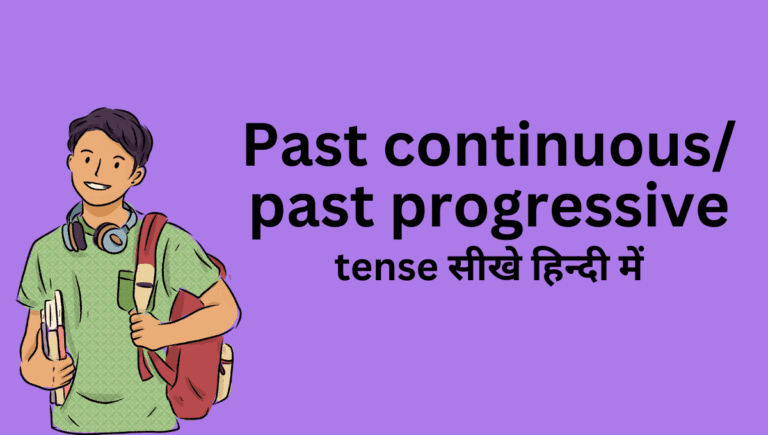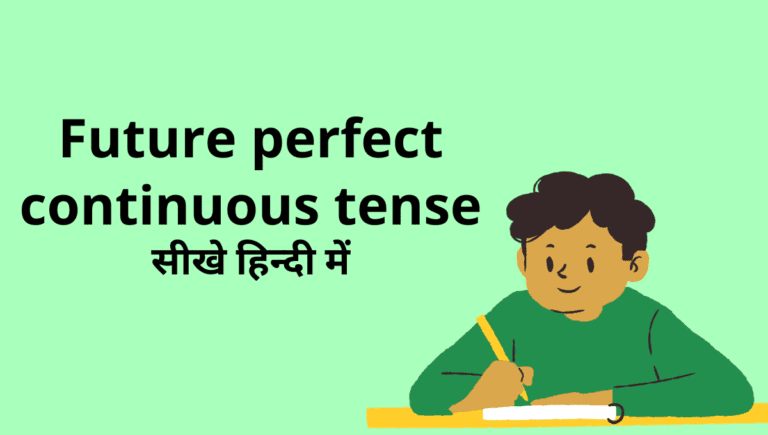हैलो दोस्तों आज की इस पोस्ट पास्ट कंटीन्यूअस टेंस (past continuous tense in Hindi) में हम past continuous tense को हिन्दी में सीखेंगे। Past continuous tense को हम past progressive tense भी कहते है। इस पोस्ट में हम past continuous tense की परिभाषा (definition), पहचान, सूत्र (formulas) और वाक्यों में उपयोग (past continuous tense sentences in hindi) भी सीखेंगे।
तो चलिए इस पोस्ट (past continuous tense in Hindi) मे पास्ट कंटीन्यूअस टेंस को डीटेल में जानते है, और बहुत ही सरल भाषा में समझते है। जिससे आपको future मे कभी भी इस टेन्स मे कोई परेशानी ना हो।
Past continuous / Past progressive tense in Hindi
Past continuous tense (अपूर्ण भूतकाल), past tense (भूतकाल) का दूसरा टेन्स है, जैसा की आप नीचे देख सकते है:
Past tense (भूतकाल) के चार प्रकार –
- Simple past tense (सामान्य भूतकाल)
- Past continuous tense (अपूर्ण भूतकाल / निरंतर भूतकाल)
- Past perfect tense (पूर्ण भूतकाल)
- Past perfect continuous tense (पूर्ण-अपूर्ण भूतकाल)
Note- Past continuous tense (अपूर्ण भूतकाल) को past progressive tense (प्रगतिशील भूतकाल) भी कहते है।
Past continuous tense की परिभाषा
अपूर्ण भूतकाल की परिभाषा – वह टेन्स जिसमे कार्य के भूतकाल (बीते हुए समय) में निरंतर होने का पता चलता है, उसे अपूर्ण भूतकाल (past continuous tense) कहते है।
जैसे –
- माँ खाना बना रही थी। (Mother was cooking food.)
- बच्चे स्कूल जा रहे थे। (The children were going to school.)
ऊपर दिए गए दोनों वाक्यों में कार्य बीते हुए समय में लगातार जारी है।
Past continuous tense meaning in Hindi
Past continuous tense का हिंदी अर्थ होता है- “अपूर्ण भूतकाल / निरंतर भूतकाल”।
Past continuous tense की पहचान
जिन हिन्दी वाक्यों के अंत में रहा था, रही थी, रहे थे आदि शब्द आते है, तथा कार्य के लगातार बीते हुए समय में होने का पता चलता है। वहाँ past continuous tense होता है।
सामान्य शब्दों मे कहे तो past continuous tense में काम भूतकाल मे लगातार चलता रहता है। जैसे- “मोहन कल नाच रहा था।” इस वाक्य में मोहन भूतकाल मे नाच रहा था। जो की एक लगातार किया जाने वाला काम है।
Past continuous tense का उपयोग
इस टेन्स का उपयोग करते समय हमे निम्न बातों का ध्यान रखना चाहिए:
- इस टेन्स में verb की 1st form के साथ हमेशा ing का उपयोग किया जाता है।
- इस टेन्स में helping verb के रूप में was और were का उपयोग होता है। और इनका उपयोग इस प्रकार किया जाता है-
Was – I, he, she, it, name, singular (एकवचन) के साथ।
Were – We, you, they, plural (बहुवचन) के साथ।
Past continuous tense के formulas

Subject + was/were + verb 1st form + ing + object. (for positive sentence)
Subject + was/were + not + verb 1st form + ing + object. (for negative sentence)
Was/ Were + subject + verb 1st form + ing + object? (for interrogative sentence)
Was/ Were + subject + not + verb 1st form + ing + object? (for interro-negative sentence)
{Or}
Was/ Were + not + subject + verb 1st form + ing + object? (for interro-negative sentence)
Types of sentences in “Past continuous tense”
Past continuous tense के वाक्यों को हम चार भागों में बाँट सकते है:
Past continuous sentences in hindi –
- Positive sentence (सकारात्मक वाक्य)
- Negative sentence (नकारात्मक वाक्य)
- Interrogative sentence (प्रश्नवाचक वाक्य)
- Negative Interrogative sentence (नकारात्मक प्रश्नवाचक वाक्य)
Positive sentence
Formula
Subject + was/were + verb 1st form + ing + object.
Examples in Hindi and English
1.) वह अपना काम कर रहा था।
1.) He was doing his work.
2.) नेहा कल रात अपने पापा से बात कर रही थी।
2.) Neha was talking to her father last night.
3.) हम अरिजीत सिंह के गाने सुन रहे थे।
3.) We were listening to Arijit Singh’s songs.
4.) विद्यार्थी बहुत ही ध्यान से पढ़ रहे थे।
4.) The students were reading very carefully.
5.) कल शाम अंधेरा हो रहा था।
5.) It was getting darker yesterday evening.
ऊपर दिए गए वाक्यों में आप देख सकते है, की हमने was / were और verb की 1st form के साथ ing (doing, talking, listening, reading, getting) का उपयोग किया है।
Negative sentence
Formula
Subject + was/were + not + verb 1st form +ing + object.
Note: कई जगह आपने was not, were not की जगह wasn’t, weren’t भी लिखा हुआ देखा होगा। तो आप परेशान मत हो क्योंकि was not, wasn’t और were not, weren’t दोनों एक ही है। wasn’t, was not का और weren’t, were not का शॉर्ट फॉर्म है।
(Full form) – (short form)
- Was not – wasn’t
- Were not – weren’t
Examples in Hindi and English
1.) वह अपना काम नहीं कर रहा था।
1.) He was not doing his work.
2.) नेहा कल रात अपने पापा से बात नहीं कर रही थी।
2.) Neha was not talking to her father last night.
3.) हम अरिजीत सिंह के गाने नहीं सुन रहे थे।
3.) We weren’t listening to Arijit Singh songs.
4.) विद्यार्थी बहुत ही ध्यान से नहीं पढ़ रहे थे।
4.) The students were not reading very carefully.
5.) कल शाम अंधेरा नहीं हो रहा था।
5.) It wasn’t getting dark yesterday evening.
ऊपर दिए गए वाक्यों मे आप देख सकते है की, हमने was / were के साथ not का उपयोग किया है। और verb की form मे ing (doing, talking, listening, reading, getting) जोड़ा है।
Interrogative sentence
Formula
Was/ Were + subject + verb 1st form + ing + object?
Note – Interrogative sentence में हमेशा प्रश्नवाचक चिन्ह (?) लगता है।
Examples in Hindi and English
1.) क्या वह अपना काम कर रहा था?
1.) Was he doing his work?
2.) क्या नेहा कल रात अपने पापा से बात कर रही थी?
2.) Was Neha talking to her father last night?
3.) क्या हम अरिजीत सिंह के गाने सुन रहे थे?
3.) Were we listening to Arijit Singh songs?
4.) क्या विद्यार्थी बहुत ही ध्यान से पढ़ रहे थे?
4.) Were the students reading very carefully?
5.) क्या कल शाम अंधेरा हो रहा था?
5.) Was it getting dark yesterday evening?
ऊपर दिए गए वाक्यों मे आप देख सकते है की interrogative sentence में हम was / were के साथ verb की 1st form+ing (doing, talking, listening, reading, getting) का उपयोग करते है। और वाक्य के अंत में प्रश्नवाचक चिन्ह (?) लगाते है।
Negative interrogative sentence
Formula
Was/ Were + subject + not + verb 1st form + ing + object?
{Or}
Was/ Were + not + subject + verb 1st form + ing + object?
Note-
- Negative interrogative sentence में हमेशा प्रश्नवाचक चिन्ह (?) लगता है।
- Negative interrogative sentence को interro-negative sentence भी कहते है।
Examples in Hindi and English
1.) क्या वह अपना काम नहीं कर रहा था?
1.) Was he not doing his work?
2.) क्या नेहा कल रात अपने पापा से बात नहीं कर रही थी?
2.) Was Neha not talking to her father last night?
3.) क्या हम अरिजीत सिंह के गाने नहीं सुन रहे थे?
3.) Weren’t we listening to Arijit Singh songs?
4.) क्या विद्यार्थी बहुत ही ध्यान से नहीं पढ़ रहे थे?
4.) Were the students not reading very carefully?
5.) क्या कल शाम अंधेरा नहीं हो रहा था?
5.) Wasn’t it getting dark yesterday evening?
ऊपर दिए गए वाक्यों मे आप देख सकते है की interrogative sentence में हम was / were के साथ not का उपयोग करते है, और verb की 1st form के साथ ing (doing, talking, listening, reading, getting) का उपयोग करते है। और वाक्य के अंत में प्रश्नवाचक चिन्ह (?) लगाते है।
Past continuous tense examples in Hindi
Past continuous tense को और भी अच्छे से समझने के लिए आप कुछ और पास्ट कंटीन्यूअस टेंस के हिन्दी उदाहरण (past continuous tense examples in Hindi) नीचे देख सकते है:
1.) वह किसी से मिलने जा रहा था।
1.) He was going to meet someone.
2.) क्या वह अकेली नहीं बैठी हुई थी?
2.) Wasn’t she sitting alone?
3.) हम फुटबॉल खेलने जा रहे थे।
3.) We were going to play football.
4.) कर्मचारी महीने के पहले दिन अपनी तनख्वाह का इंतजार कर रहे थे।
4.) The employees were waiting for their salaries on the first day of the month.
5.) जब फोन बज रहा था तो मैं बाथरूम में था।
5.) When the phone was ringing, I was in the bathroom.
6.) तुम्हें गलतफहमी हुई होगी, विवेक तुम्हारे बारे में बुरा नहीं कह रहा था।
6.) You must have misunderstood, Vivek was not saying bad things about you.
7.) क्या कल शाम बारिश के साथ ओले गिर रहे थे?
7.) Were hailstones falling with the rain yesterday evening?
8.) शिक्षक छात्रों को परीक्षा की तैयारी करा रहे थे।
8.) Teacher was making students prepare for the exam.
9.) प्रिंसिपल के भाषण के बाद सभी ताली बजा रहे थे।
9.) Everyone was clapping after the principal’s speech.
10.) क्या रानी अपनी परेशानी के बारे में नहीं बता रही थी?
10.) Was Rani not telling about her troubles?
Past continuous tense FAQs
पास्ट कंटीन्यूअस टेंस (Past continuous tense) का हिंदी अर्थ होता है- “निरंतर भूतकाल”।
पास्ट कंटीन्यूअस टेंस (Past continuous tense) में सहायक क्रिया के रूप में was और were का उपयोग किया जाता है। और इनका उपयोग इस प्रकार किया जाता है-
Was – He, she, it, name, singular (एकवचन) के साथ।
Were – I, we, you, they, plural (बहुवचन) के साथ।
जिन हिन्दी वाक्यों के अंत में रहा था, रही थी, रहे थे आदि शब्द आते है, तथा कार्य के लगातार बीते हुए समय में होने का पता चलता है। वहाँ past continuous tense होता है।
Conclusion
इस पोस्ट (past continuous tense in Hindi) में हमने past continuous tense के बारे में जाना। और साथ ही साथ पास्ट कंटीन्यूअस टेंस की परिभाषा (definition of past continuous tense) और उसके उपयोग (uses of past continuous tense) सीखे।
हमें आशा है की आपको यह पोस्ट (past continuous tense in Hindi to English) पसंद आयी होगी। अगर आपका इस पोस्ट से संबंधित कोई सवाल हो तो आप comment में पूछ सकते है।
हमसे जुड़े रहने के लिए आप हमे Instagram और Facebook पर भी फॉलो कर सकते है-
- Instagram – @english_learner_podcast
- Facebook – @English learner podcast
इस तरह की और भी पोस्ट पढ़े –
Past Tense (भूतकाल)




